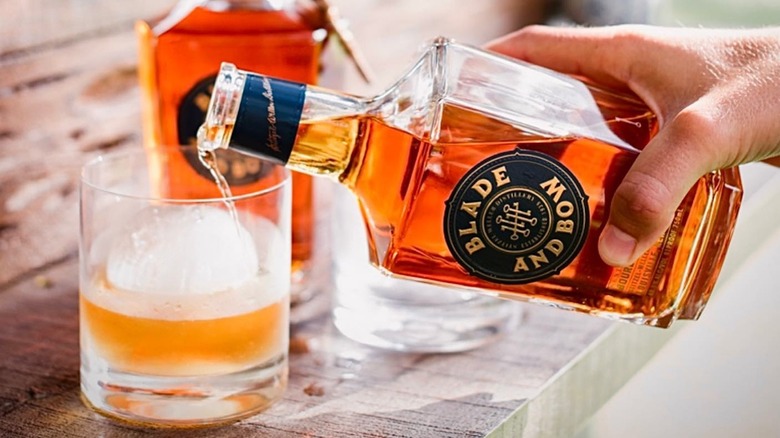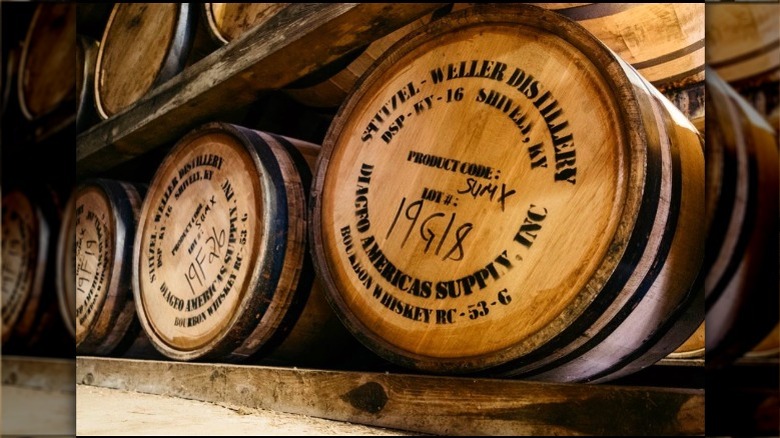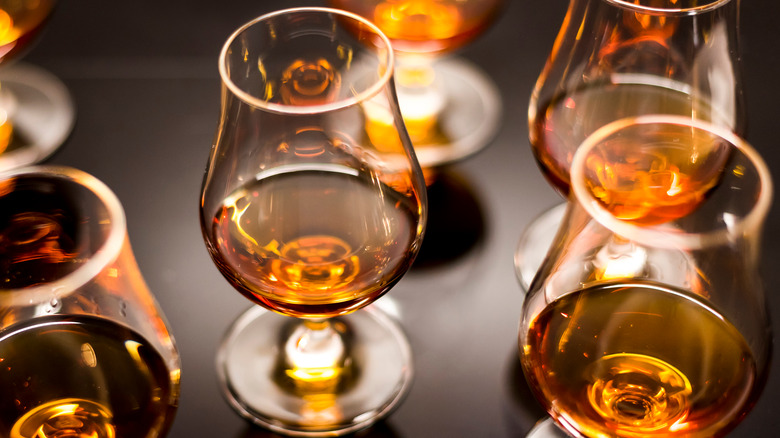Blade And Bow Bourbon's Historic Connection To A Famous Louisville Distillery
Celebrating its tenth anniversary this year, Blade and Bow Distillery is well-known for being the brand that took over the Stitzel-Weller distillery in Louisville, Kentucky, otherwise known as the Cathedral of Bourbon. The name of the new distillery pays homage to Stitzel-Weller's history, as the logo of Stitzel-Weller consisted of five keys which symbolized the five steps of bourbon production: grains, yeast, fermentation, distillation, and aging. According to its website, Blade and Bow took this idea and christened itself "after the two parts of a skeleton key, the blade shaft and the ornate bow."
Blade and Bow have only two products, and its narrow focus translates into premium flavor. There's the Blade and Bow Kentucky Straight Bourbon Whiskey and the 22-Year-Old Kentucky Straight Bourbon Whiskey, which gets released in limited batches each year. The limited release is a great project, but the brand's flagship bourbon is where the company really stands out.
What makes Blade and Bow's bourbon unique is its use of solera aging. This aging method has you stack barrels in a pyramid so that the distillery has five tiers of bourbon barrels stacked on top of each other. When the distillery is ready to bottle the whiskey, it's pulled from the bottom layer, which is then refilled with whiskey from the fourth layer, which is refilled with the third layer, and so on. When Blade and Bow moved in, it inherited several barrels of 21-year-old Stitzel-Weller-produced bourbon. By using the solera method, it can prolong the use of this legendary whiskey instead of a one-time release.
The Cathedral of Bourbon is a legendary piece of bourbon history
The 20th century was responsible for a monumental shift in how Americans think about bourbon, and a good chunk of that history is intertwined with the Stitzel-Weller Distillery. Opened in 1935 on the day of the Kentucky Derby by none other than Julian P. Van Winkle Sr. (more widely known by his nickname Pappy Van Winkle), the Stitzel-Weller distillery would go on to produce some of the most iconic and most expensive bottles of bourbon to ever exist.
Pappy Van Winkle is such a legendary figure in the whiskey world that many people question if he ever existed at all, but rest assured, he was very real and every bit as good at his craft as his reputation would suggest. Pappy Van Winkle passed away in 1965, and his son Julian, Jr. took over the distilling business. But in 1972, the shareholders of the company pressed for the distillery to be sold to the conglomerate Norton Simon.
After the sale, the distillery became known as the Old Fitzgerald Distillery. There was a period of time where the Van Winkles still operated inside the building despite not owning it but, eventually, that would also come to an end. Despite the bourbon boom in the '80s, the distillery closed for good in 1992. So, how is it that Blade and Bow bourbon came to call Stitzel-Weller home?
Stitzel-Weller has passed the torch to a new generation of bourbon makers
The Stitzel-Weller distillery isn't the same beast it was last century since ownership of the building has passed hands over the years. But in 2014, the closed-down Old Fitzgerald Distillery was sold to the massive beverage company Diageo, whose brand portfolio includes such titans as Tanqueray, Johnnie Walker, and Bulleit. When Diageo initially bought the building, the company converted it into a tasting room for Bulleit as part of the Kentucky Bourbon Trail. Today, it serves primarily as the distillery for Diageo's Blade and Bow.
Despite only having two products, Blade and Bow is gaining popularity thanks in no small part to its association with the Stitzel-Weller Distillery. To honor that heritage the brand has gone back to calling it Stitzel-Weller instead of Old Fitzgerald. Blade and Bow aren't the only ones operating out of the space though. I.W. Harper and Orphan Barrel are two of the other Diageo whiskey brands connected to the new Stitzel-Weller Distillery.
The mystery around Old Van Winkle and other Van Winkle whiskey products remains strong to this day and people are willing to pay top dollar to get their hands on the stuff. But you don't need to drop thousands of dollars on a 750-milliliter bottle of whiskey to enjoy a sip of that history. Blade and Bow's award-winning blend will do just fine.


